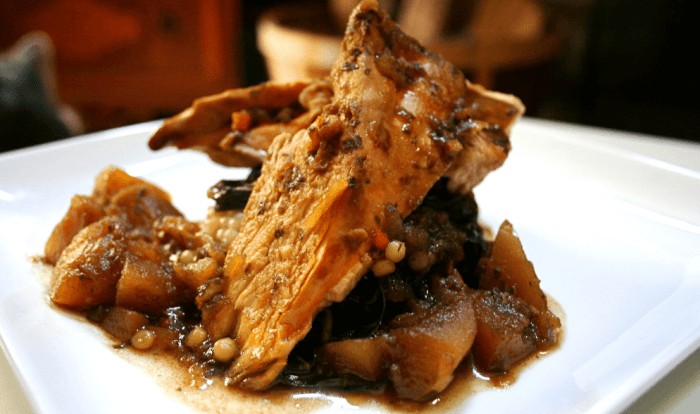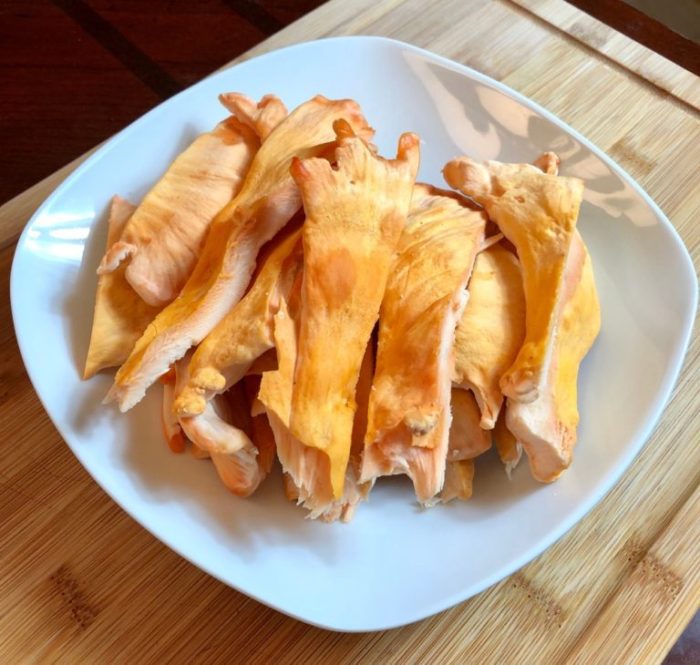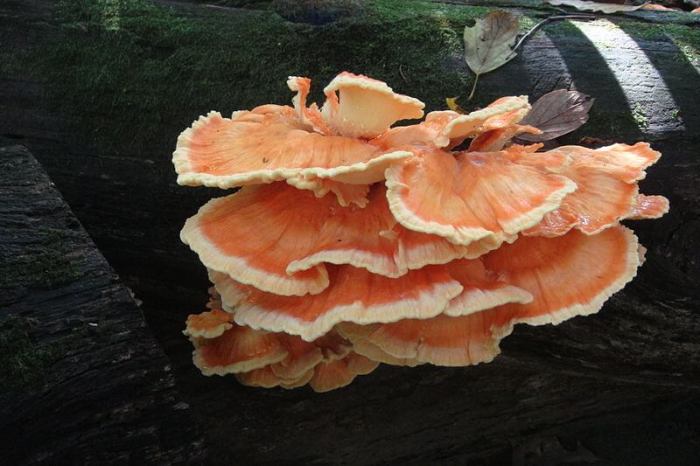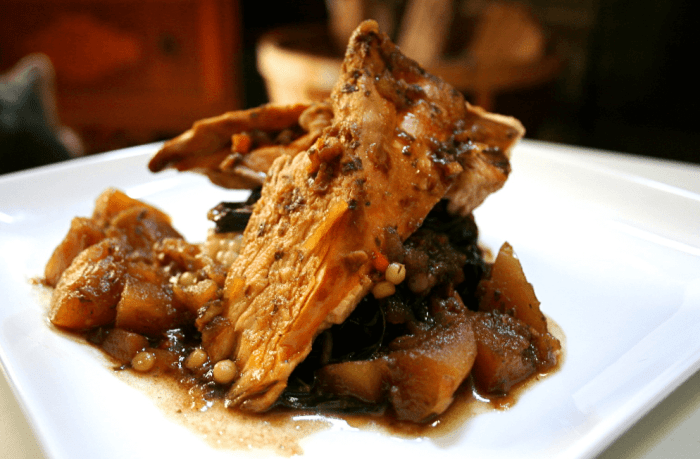
Embark on a culinary adventure with the chicken of the woods recipe, a delectable and versatile mushroom that tantalizes taste buds and ignites culinary creativity. Dive into the distinctive flavors and textures of this extraordinary ingredient, and discover its culinary applications that will elevate your dishes to new heights.
From foraging and identification to preparation and cooking techniques, this guide empowers you to harness the full potential of chicken of the woods. Uncover its nutritional benefits, explore popular recipes, and learn essential precautions to ensure safe and enjoyable consumption.
Culinary Applications of Chicken of the Woods

Chicken of the woods, with its unique flavor and texture, is a versatile culinary delight. Its meaty texture and slightly sweet, nutty flavor make it an excellent substitute for chicken in various dishes.
Preparation and Cooking Tips
Before cooking, clean the chicken of the woods thoroughly to remove any dirt or debris. Cut into bite-sized pieces or shred for easier preparation. Chicken of the woods can be cooked using various methods, including sautéing, grilling, roasting, or frying.
Sautéing is a quick and easy method that brings out the mushroom’s flavors. Grill or roast chicken of the woods for a smoky, charred flavor. Frying creates a crispy exterior with a tender interior.
Versatility in Dishes
Chicken of the woods’ versatility shines in its ability to complement various dishes. It can be used in soups, stews, and casseroles, adding a meaty texture and umami flavor. Shredded chicken of the woods can be added to tacos, burritos, or sandwiches as a flavorful substitute for pulled chicken.
It can also be grilled or roasted and served as a side dish or as part of a vegetarian or vegan platter.
Identification and Foraging of Chicken of the Woods: Chicken Of The Woods Recipe
Chicken of the woods (Laetiporus sulphureus) is a distinctive and edible mushroom that can be found in forests throughout North America. It is known for its bright orange or yellow coloration and its meaty texture, which resembles that of chicken.
For those who love to experiment with new and exciting recipes, chicken of the woods is a must-try. This mushroom can be used to create a wide range of dishes, from hearty soups and stews to flavorful tacos and stir-fries.
Its versatility makes it a great choice for any home cook looking to add some variety to their meals.
Identifying and foraging chicken of the woods safely requires careful observation and knowledge of its characteristics.
Distinctive Characteristics
Chicken of the woods typically grows in clusters on the trunks of dead or dying hardwood trees, such as oaks, maples, and beeches. The mushroom has a shelf-like or fan-shaped appearance, with a wavy or lobed margin. The upper surface is bright orange or yellow, while the underside is white or cream-colored, with small pores.
Identification Guidelines
To safely identify chicken of the woods, it is important to observe its key characteristics:
- Color:Bright orange or yellow on the upper surface, white or cream on the underside
- Shape:Shelf-like or fan-shaped, with a wavy or lobed margin
- Pores:Small, round pores on the underside
- Habitat:Grows on the trunks of dead or dying hardwood trees
Foraging Safety
While chicken of the woods is generally considered edible, it is important to take precautions when foraging. Some people may be allergic to the mushroom, and it is not recommended for pregnant or nursing women. Additionally, it is crucial to identify the mushroom accurately to avoid confusion with toxic lookalikes.
If you’re looking for a delicious and easy-to-make chicken dish, look no further than chicken of the woods . This unique mushroom has a meaty texture and a slightly earthy flavor, making it a great substitute for chicken in any recipe.
Whether you’re frying, grilling, or roasting it, you’re sure to enjoy this versatile and flavorful ingredient.
When foraging for chicken of the woods, it is advisable to:
- Consult with experienced mushroom foragers or use reliable field guides
- Avoid mushrooms that show signs of decay or damage
- Cook the mushrooms thoroughly before eating
Potential Risks and Benefits
Foraging for chicken of the woods can be a rewarding experience, but it is important to be aware of the potential risks and benefits involved:
Risks
- Allergic reactions:Some people may experience allergic reactions to chicken of the woods, ranging from mild to severe
- Toxic lookalikes:There are several toxic mushrooms that resemble chicken of the woods, such as the Jack-o’-lantern mushroom (Omphalotus illudens)
Benefits
- Nutritional value:Chicken of the woods is a good source of protein, fiber, and vitamins
- Culinary versatility:The mushroom can be cooked in various ways, including sautéing, grilling, or roasting
- Sustainability:Foraging for chicken of the woods is a sustainable practice that helps preserve the natural ecosystem
Nutritional Profile of Chicken of the Woods
Chicken of the woods ( Laetiporus sulphureus) is a polypore mushroom known for its bright orange color and meaty texture. It is a good source of several nutrients, including fiber, protein, and antioxidants.
Compared to other mushrooms, chicken of the woods is a good source of protein. It contains about 3 grams of protein per 100 grams of fresh weight, which is higher than most other mushrooms. Chicken of the woods is also a good source of fiber, with about 2 grams per 100 grams of fresh weight.
Fiber is important for digestive health and can help to lower cholesterol levels.
Potential Health Benefits
In addition to its nutritional value, chicken of the woods may also have several health benefits. Some studies have shown that chicken of the woods may have anti-inflammatory and antioxidant properties. These properties may help to protect against chronic diseases such as heart disease and cancer.
Popular Recipes and Cooking Methods

Chicken of the woods is a versatile mushroom that can be used in various culinary preparations. Its unique flavor and texture make it a popular choice for both vegetarians and meat-eaters alike. Here are some popular recipes and cooking methods for chicken of the woods:
Chicken of the woods can be grilled, sautéed, roasted, or fried. Each cooking method imparts a different flavor and texture to the mushroom. Grilling chicken of the woods gives it a smoky flavor, while sautéing it in butter or oil brings out its nutty flavor.
Roasting chicken of the woods intensifies its umami flavor, and frying it gives it a crispy texture.
Flavor and Texture Enhancements
- Marinate chicken of the woods in a mixture of olive oil, lemon juice, garlic, and herbs before cooking to enhance its flavor.
- Add chicken of the woods to soups, stews, and casseroles for a boost of flavor and texture.
- Use chicken of the woods as a meat substitute in vegetarian and vegan dishes.
Health Considerations and Precautions

Chicken of the woods is generally safe to consume when properly identified and cooked. However, like all wild mushrooms, it’s crucial to exercise caution to avoid potential health risks.
Individuals with mushroom allergies or sensitivities should avoid consuming chicken of the woods. Additionally, pregnant or breastfeeding women, as well as those with compromised immune systems, should consult a healthcare professional before consuming wild mushrooms.
Safe Consumption and Storage, Chicken of the woods recipe
- Always ensure accurate identification by an experienced mushroom forager or expert.
- Cook chicken of the woods thoroughly before eating to kill any potential bacteria or parasites.
- Store fresh chicken of the woods in the refrigerator for up to 5 days.
- For longer storage, dry or freeze chicken of the woods to preserve its flavor and nutritional value.
Consulting Healthcare Professionals
Before consuming any wild mushrooms, it’s highly recommended to consult with a healthcare professional, especially if you have any underlying health conditions or concerns.
A healthcare professional can provide personalized advice based on your individual health profile and help you make informed decisions about consuming chicken of the woods.
Final Thoughts

Chicken of the woods is a culinary gem, offering a unique blend of flavors and textures that enhance any dish. Whether you’re a seasoned chef or a home cook seeking culinary inspiration, this guide provides a comprehensive exploration of this remarkable mushroom.
Embrace the versatility of chicken of the woods and embark on a gastronomic journey that will delight your palate and expand your culinary horizons.
General Inquiries
Is chicken of the woods safe to eat?
Yes, chicken of the woods is generally considered safe to eat when properly identified and cooked. However, it’s important to consult with experts or use field guides to ensure accurate identification.
How do I cook chicken of the woods?
Chicken of the woods can be cooked in various ways, including grilling, sautéing, roasting, or adding it to soups and stews. Cooking enhances its flavors and textures, making it a versatile ingredient.
What does chicken of the woods taste like?
Chicken of the woods has a unique flavor that is often described as a cross between chicken and seafood. It has a meaty texture and a slightly sweet and nutty taste.





